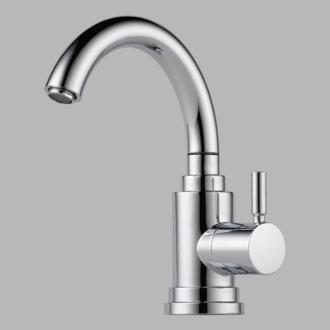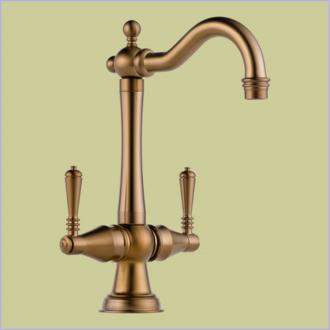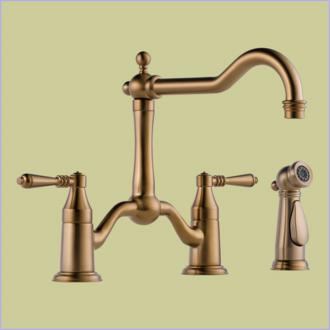Why Change the Kitchen Faucet
As more and more people decide not to move and instead remodel their existing homes, they don’t realize that they can start small and add value by simply replacing the faucets in their kitchens and bathrooms. Adding something simple such as a faucet gives the look of a newer kitchen, while at the same time, saving cost and the environment through lower water usage. Most people don’t even realize how easy it is to replace their kitchen faucet. After picking one out, such as these examples from Brizo…
How to Replace a Kitchen Faucet
The most difficult part of replacing a faucet is removing the old one. Once the old stuff is out of the way, your new faucet should go in easily.
Removing an Old Faucet
Step 1
Shut off the water. You can turn off the main water valve, or turn off the two valves immediately under the faucet you’re replacing. Then, open the faucet and allow it to drain and release any pressure.
Step 2
Disconnect the water supply lines. If you choose not to replace the lines, disconnect them from the faucet only. If you choose to replace them, disconnect the lines from the shut-off valve. It’s a good idea to change them now since you’re going to the trouble of replacing the faucet. It could save you an extra trip under the sink later.
Step 3
Remove the faucet from the sink. Faucets are mounted in two ways: Bottom-mount faucets are removed from above. For these, the handles and escutcheons must be removed to get to the nuts, which secure the faucet in place. Top-mount faucets are held in place by nuts located underneath the sink and must be removed from below. The nuts may be loosened using waterpump pliers or a special basin wrench. The basin wrench is necessary when the area in which the nut is located is too tight to allow for the use of pliers.
If it’s an old sink and the nuts are rusted or corroded in place, apply penetrating oil and allow it to work into the threads before trying to remove the nuts.
Once the faucet has been removed, a buildup may be present on the sink in the area where the faucet plate or escutcheons were attached. Clean it off to make ready for the new faucet. A 50-50 solution of vinegar and water will help dissolve the buildup. Scrape it away with a razor blade or a scouring pad.
Installing a Top-Mount Faucet
Step 1
Apply a bead of plumber’s putty or silicone caulk around the faucet base. Some faucets have rubber or plastic gaskets for the base and don’t require this step.
Step 2
Ease the faucet into place, pressing against the putty to assure a good seal.
Step 3
Under the sink, install the washers and mounting nuts on the tailpieces. Tighten the nuts by hand.
Step 4
Align the faucet with the back of the sink, and tighten the mounting nuts with waterpump pliers, an adjustable wrench or a basin wrench. Wipe away excess putty or caulk from around the base.
Installing a Bottom-Mount Faucet
Step 1
From under the sink, hold the faucet in place.
Step 2
Install the washers and mounting nuts, tightening the nuts by hand. Align the faucet with the back of the sink, and tighten the mounting nuts with waterpump pliers or a wrench.
Step 3
Run a bead of plumber’s putty or silicone caulk along the base of the escutcheons and screw them in place.
Step 4
Install the faucet handles. The one marked Hot should go on the left. Wipe away excess putty from around the base of the escutcheons.
Hooking Up Supply Lines
If you’ve chosen not to replace your supply lines, you can simply hook them back up and turn on the water. If you’ve chosen to use new lines, your job isn’t much more difficult.
Different types of supply lines are available. Chromed copper lines are the most difficult to replace. You must buy the right length and then bend them as necessary to make them work. They’re the most attractive, however, and are often used with wall-mounted sinks or in any installation in which the supply lines are exposed. Flexible lines are allowed in many locations. They’re inexpensive, can be cut to size with a knife and are very easy to use. Flexible plastic and braided metal supply lines are also available.
Copper supply tubes have a rounded end that fits into the seats of the faucet’s water inlets. When the coupling nut is tightened, the end seals itself against the seat. The supply tubes are connected with the included compression fittings to the shutoff valve.
Attaching a Sink Sprayer
If you’re installing a kitchen sink, you may also need to attach a kitchen sprayer.
Step 1
Apply a bead of plumber’s putty to the base of the sprayer holder. Insert the holder into the hole, and tighten it in place with the mounting nut. Wipe away any excess plumber’s putty from around the base of the holder.
Step 2
Insert the supply tube of the sprayer through the holder from the top. The sprayer will sit in place in the holder.
Step 3
Under the sink, screw the sprayer supply hose to the hose nipple on the bottom of the faucet. Tighten the nut with a wrench or waterpump pliers.
Following these easy steps to update your faucet in the kitchen will not only give you the look you want, but it will be more sufficient with saving water every time you turn it on. Visit Plumbtile today to view are many designs of faucets to complete your kitchen needs.




